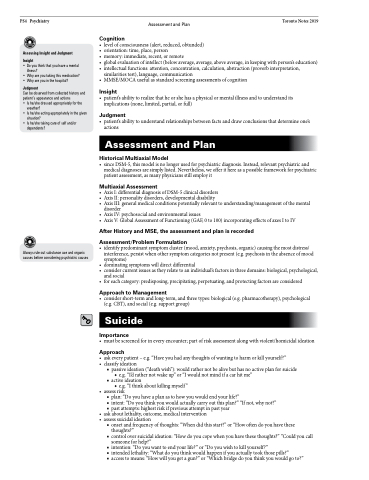Page 1168 - TNFlipTest
P. 1168
PS4 Psychiatry
Assessment and Plan
Toronto Notes 2019
Assessing Insight and Judgment
Insight
• Do you think that you have a mental illness?
• Why are you taking this medication?
• Why are you in the hospital?
Judgment
Can be observed from collected history and patient’s appearance and actions
• Is he/she dressed appropriately for the
weather?
• Is he/she acting appropriately in the given
situation?
• Is he/she taking care of self and/or
dependents?
Cognition
• levelofconsciousness(alert,reduced,obtunded)
• orientation: time, place, person
• memory:immediate,recent,orremote
• globalevaluationofintellect(belowaverage,average,aboveaverage,inkeepingwithperson’seducation) • intellectualfunctions:attention,concentration,calculation,abstraction(proverbinterpretation,
similarities test), language, communication
• MMSE/MOCA useful as standard screening assessments of cognition
Insight
• patient’sabilitytorealizethatheorshehasaphysicalormentalillnessandtounderstandits implications (none, limited, partial, or full)
Judgment
• patient’sabilitytounderstandrelationshipsbetweenfactsanddrawconclusionsthatdetermineone’s actions
Assessment and Plan
Historical Multiaxial Model
• sinceDSM-5,thismodelisnolongerusedforpsychiatricdiagnosis.Instead,relevantpsychiatricand medical diagnoses are simply listed. Nevertheless, we offer it here as a possible framework for psychiatric patient assessment, as many physicians still employ it
Multiaxial Assessment
• AxisI:differentialdiagnosisofDSM-5clinicaldisorders
• AxisII:personalitydisorders,developmentaldisability
• AxisIII:generalmedicalconditionspotentiallyrelevanttounderstanding/managementofthemental
disorder
• AxisIV:psychosocialandenvironmentalissues
• AxisV:GlobalAssessmentofFunctioning(GAF,0to100)incorporatingeffectsofaxesItoIV
After History and MSE, the assessment and plan is recorded
Assessment/Problem Formulation
• identifypredominantsymptomcluster(mood,anxiety,psychosis,organic)causingthemostdistress/ interference, persist when other symptom categories not present (e.g. psychosis in the absence of mood symptoms)
• dominatingsymptomswilldirectdifferential
• considercurrentissuesastheyrelatetoanindividual’sfactorsinthreedomains:biological,psychological,
and social
• foreachcategory:predisposing,precipitating,perpetuating,andprotectingfactorsareconsidered
Approach to Management
• considershort-termandlong-term,andthreetypes:biological(e.g.pharmacotherapy),psychological (e.g. CBT), and social (e.g. support group)
Suicide
Importance
• mustbescreenedforineveryencounter;partofriskassessmentalongwithviolent/homicidalideation
Approach
• askeverypatient–e.g.“Haveyouhadanythoughtsofwantingtoharmorkillyourself?” • classifyideation
■ passive ideation (“death wish”): would rather not be alive but has no active plan for suicide ◆ e.g. “I’d rather not wake up” or “I would not mind if a car hit me”
■ active ideation
◆ e.g. “I think about killing myself ”
• assessrisk
■ plan: “Do you have a plan as to how you would end your life?”
■ intent: “Do you think you would actually carry out this plan?” “If not, why not?” ■ past attempts: highest risk if previous attempt in past year
• askaboutlethality,outcome,medicalintervention • assesssuicidalideation
■ onset and frequency of thoughts: “When did this start?” or “How often do you have these thoughts?”
■ control over suicidal ideation: “How do you cope when you have these thoughts?” “Could you call someone for help?”
■ intention: “Do you want to end your life?” or “Do you wish to kill yourself?”
■ intended lethality: “What do you think would happen if you actually took those pills?”
■ access to means: “How will you get a gun?” or “Which bridge do you think you would go to?”
Always rule out substance use and organic causes before considering psychiatric causes


